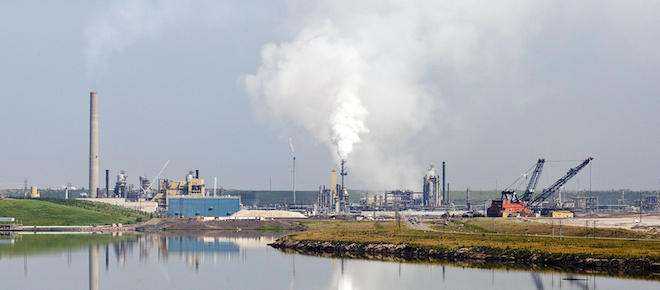How not to be fooled by statements on emission ‘reductions’
Andrew Leach explains, with the help of chicken wings and beer
The Syncrude oil sands facility is reflected in a tailings pond near Fort McMurray, Alta., Tuesday, July 10, 2012.THE CANADIAN PRESS/Jeff McIntosh
Share

Suppose you run into an old friend whom you haven’t seen for some time. You notice that he looks a little thicker than you remembered around the waist, but, since you aren’t one of those academics who shuns basic manners, you keep mum.
“How are you doing?” you say, “What’s new?”
His response leaves you shocked: “I feel great!” he tells you, “I’ve lost 20 pounds.”
Despite your best efforts, you can’t hide your scepticism.
“It’s simple, really,” he says. “On the path I was on — eating chicken wings and drinking beer almost every day — I would surely have gained 40 pounds in no time. I stuck to my plan, though, and by having wings and beer only on weekends, I gained a mere 20 pounds. Who would have thought you could drink beer, eat chicken wings, and still lose weight!”
Sounds like an absurd calculation, doesn’t it? This type of thinking, though, is the bread-and-butter of discussions about greenhouse gas policies — it’s called a reduction relative to business-as-usual. A case in point is this week’s Emissions Trends report from Environment Canada, were you can read the following:
As a result of the combined efforts of federal, provincial and territorial governments, consumers and businesses, GHG emissions in 2020 will be 734 megatonnes (Mt). This is 128 Mt lower than where emissions would be in 2020 if no action were taken to reduce GHGs since 2005. [Emphasis mine.]
There’s nothing wrong with these calculations — in fact, you could argue that they give a far better picture of the impact policies are actually having in the economy than simply looking at changes in emissions over time. The problem, however, is that the subtlety of the reduction being measured relative to a scenario where no policies are imposed often gets lost. Take Alberta Premier Alison Redford’s recent USA Today column, which states that GHG policies “allowed our province to reduce greenhouse gas emissions by 32 million tons.” As the Calgary Herald‘s Don Braid, pointed out, such excitement about Alberta’s GHG diet “hinged on a calculation of what total emissions would have been, if the province had done nothing at all.” Of course, Alberta’s emissions haven’t declined at all — they’ve increased significantly and are projected to continue to do so.
Next time someone tells you about an emissions reduction (or a weight loss regime, for that matter) that seems too good to be true, make sure you ask one clarifying question: Reduction relative to what?
*Disclosure: The author recently spent a year on secondment as the first Visiting Scholar at Environment Canada.